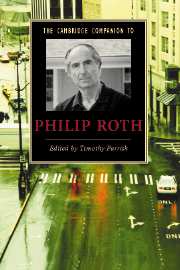Book contents
- Frontmatter
- Introduction: Roth at mid-career
- 1 American-Jewish identity in Roth’s short fiction
- 2 Roth, literary influence, and postmodernism
- 3 Zuckerman Bound: the celebrant of silence
- 4 Roth and the Holocaust
- 5 Roth and Israel
- 6 Roth’s doubles
- 7 Revisiting Roth’s psychoanalysts
- 8 Roth and gender
- 9 Roth and ethnic identity
- 10 Roth’s American Trilogy
- 11 Roth’s autobiographical writings
- Further reading
- Index
4 - Roth and the Holocaust
Published online by Cambridge University Press: 28 May 2007
- Frontmatter
- Introduction: Roth at mid-career
- 1 American-Jewish identity in Roth’s short fiction
- 2 Roth, literary influence, and postmodernism
- 3 Zuckerman Bound: the celebrant of silence
- 4 Roth and the Holocaust
- 5 Roth and Israel
- 6 Roth’s doubles
- 7 Revisiting Roth’s psychoanalysts
- 8 Roth and gender
- 9 Roth and ethnic identity
- 10 Roth’s American Trilogy
- 11 Roth’s autobiographical writings
- Further reading
- Index
Summary
For most reflective American Jews, I would think, it is simply there, hidden, submerged, emerging, disappearing, unforgotten. You don't make use of it - it makes use of you.
The Holocaust, American-style
In Philip Roth's 1983 novel The Anatomy Lesson, the mother of Nathan Zuckerman, Roth's alter ego, develops a brain tumor. Admitted into the hospital for the second time, Zuckerman's mother
was able to recognize her neurologist when he came by the room, but when he asked if she would write her name for him on a piece of paper, she took the pen from his hand and instead of “Selma” wrote the word “Holocaust,” perfectly spelled. This was in Miami Beach in 1970, inscribed by a woman whose writings otherwise consisted of recipes on index cards, several thousand thank-you notes, and a voluminous file of knitting instructions. Zuckerman was pretty sure that before that morning she'd never even spoken the word aloud.
In succinct, enigmatic fashion, this passage captures the complex form that memory of the Holocaust has taken in American life and in Roth's work. The carefully situated mother's death - in Miami Beach in 1970 - testifies to the belated and displaced effect of the European catastrophe on Jewish-American identity. Alternately “disappearing” from and “emerging” into Jewish-American consciousness, as Roth once remarked in an interview, Holocaust memory has a history that Roth's fiction both reflects and anatomizes.
- Type
- Chapter
- Information
- The Cambridge Companion to Philip Roth , pp. 52 - 67Publisher: Cambridge University PressPrint publication year: 2007
- 1
- Cited by



